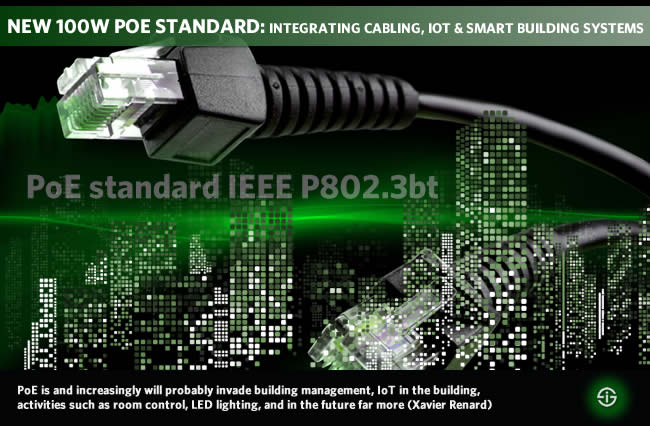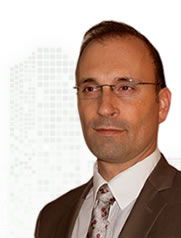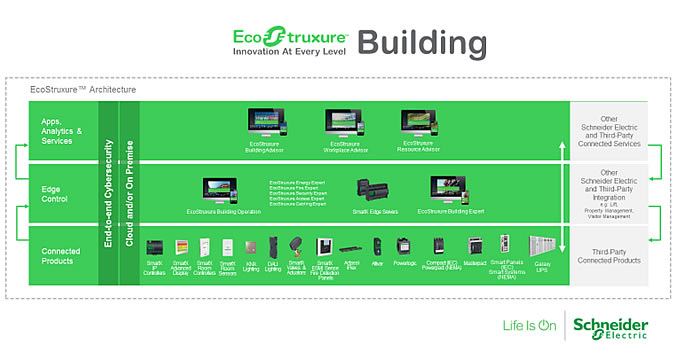What the Power over Ethernet (PoE) standard, IEEE P802.3bt, means from an integrated smart buildings systems, power, cabling, BMS and Internet of Things perspective.
After IP, the Internet of Things (IoT) became the next gamechanger in building management system evolutions, BMS expert Martin Feder says. IP and IoT, along with related technologies including advanced data analytics, enable smart buildings and help break down the silos in facility management.
Connected and integrated building optimizations are fueling the rapid evolution of today’s buildings. New ways of powering devices and transmitting data is a key trend in this evolution.
Strategic research company Dell’Oro Group predicts a clear acceleration of the use of PoE with 1 billion PoE ports within four year
For almost two decades Ethernet has been the de facto standard that feeds various building functions. With a new Power over Ethernet standard scheduled for September 2018, the possibilities of Ethernet become even greater. The building’s network is its backbone says Schneider Electric’s Future Offer Manager Xavier Renard. Designing a network that is ready for Power over Ethernet standard IEEE P802.3bt will make it future-proof when considering all the new devices to connect…and to power he says. Moreover, Xavier emphasizes, when designing and installing the building network, it’s important to understand that the race is not about bandwidth anymore but about power.

PoE: from the early days of IP to an ever-increasing role in smart buildings
The increasing role of power is precisely where the new PoE standard comes in. It’s another gamechanger that helps organizations optimize connected devices and thus optimize the intelligent building management and energy management layers on top of them.
Xavier, cabling, networks and data communications have always been essential in buildings but with the new PoE standard even more so you say, especially as it is directly linked with IoT, building management evolutions and the need for DC power in buildings and beyond. Could you first explain what Power over Ethernet is and where it comes from, especially in a building context?
Xavier Renard: Power over Ethernet goes back almost two decades with the switch from analog phones to IP phones and when IP indeed also started transforming the building landscape. IP phones are connected devices so on top of power they also needed data transmission capacities. In those days Wi-Fi wasn’t commonly used. PoE was ‘invented’ to avoid the need for two cables, one for power and one for data. And that’s the essence of PoE; using the same copper cable for data and power.
Most of the building networks today are still siloed, however the IoT’s pervasiveness is changing that. It is one area where the new PoE standard will a gamechanger.
The first standard was 15 watts with 13 watts for the phone and for a long time that was more than enough. Gradually PoE also started being used for other applications such as IP cameras while IP phones started to be equipped with screens.
Moreover, Wi-Fi became more popular. In a sense Wi-Fi also uses IoT connected devices that transmit huge amounts of data and need power: wireless access points. Here as well PoE was found to be the ideal solution and today, close to all wireless access points still use PoE, just as IP phones and IP cameras do.
As more applications were used, the need for wireless access points grew and many early IP devices started to evolve, a second PoE standard, IEEE 802.3at, was launched, going up to 30 watts (with 25.5 watts for the device), which was huge at the time and in fact is still enough for most applications, including buildings. A tablet, for instance, uses less than 30 watts, so room entry with a touchscreen with everything behind it connected with a single cable is already possible.

The 30-watt Power over Ethernet standard was the first gamechanger and opened the door for new applications. PoE now also could power the more modern Pan, Tilt and Zoom (PTZ) cameras. With these modern cameras users needed to be able to change the camera position and for outdoor cameras, a resistor was needed to remove the water inside the glass using heat. This required approximately 20 watts, more than the original 13. Today, the large majority of PTZ cameras still use PoE.
It’s clear that in the building environment new possibilities had arrived and that with the standard coming in September this will only increase.
The new 100 watt Power over Ethernet standard: connecting the foundations of connected devices and the applications of intelligent buildings
The new Power over Ethernet standard, IEEE P802.3bt, brings less wires and more power for more use cases with two additional power types: up to 55 W for Type 3 devices and up to 90-100 W of power for Type 4 devices. You say it will change the foundational level of connected devices, building cabling AND building management, that will result in more integration and less silos. Can you explain?
Xavier Renard: There are several reasons why this is so. At Schneider Electric, we have owned the PoE data communications, cabling and connector business for years as part of the company’s overall network connectivity offer.
As previously stated, the building network and connected devices level is the foundation for applications and innovations in the ongoing evolution around Schneider Electric’s IoT-enabled EcoStruxure Building offer where this integration comes into the picture. Allow me to explain.

If you look at building networks, today there are many communication networks inside a building with the typical legacy of a communication network for IT, another communication network for heating, one for energy management, one for offices and the LAN network.
Most of these networks today are still siloed, however the IoT’s pervasiveness is changing that. That’s one area where the new PoE standard will again be a gamechanger.
Secondly, there are the connected devices and IoT themselves. According to Memoori, by 2021 more than 10 billion devices will be connected in buildings. Those devices are connected and powered. For IoT devices which are not autonomous from a power perspective (no batteries) it is more and more obvious to use a thin cable with data and power; especially DC power because then you save the AC/DC conversion. This is exactly what PoE enables us to do in a cost-efficient manner.
As the cabling is already there and less used you achieve multiple benefits at once:
- you save on precious raw materials and natural resources that are often underused, certainly in today’s office (copper),
- you save energy because there is no need for AC/DC conversion
- it’s more efficient as power and connectivity are in a single cable, in a single connector, through a single installation, from DC power to DC consumption.
Look at the different networks in a building today, the role of IoT and the importance of DC power. The Internet of Things comes with electronics, and electronics use DC power. With ever more connected devices the need for DC power is increasing. Nowadays, DC power at the desk is not a nice to have, it’s mandatory. Everyone needs DC power, usually through USB (a proximity connectivity) or, worse, with an AC/DC converter, to load his/her phone/tablet/computer battery. Chance would have it, DC is already present at the desk through PoE.
As the cabling is already there, the new Power over Ethernet standard enables to save on precious raw materials, save energy, increase efficiency and most of the time there is no need to redeploy things
And it makes total sense to use the network that’s already there, the LAN network, which is less used by people because we love mobility and usually are connected through Wi-Fi. And that brings me to another benefit of PoE: most of the time you don’t need to re-deploy things.
I’m not surprised that strategic research company Dell’Oro Group predicts a clear acceleration of the use of PoE with 1 billion PoE ports within four years.
Benefits and deployment of the new Power over Ethernet standard in buildings: what consultants, integrators and installers should know
With the new Power over Ethernet standard the same cabling can be used and new opportunities are created. There also will be certifications and network design aspects to consider as you told us before. What should consultants, integrators and other partners as you find them in the EcoXpert ecosystem know about the opportunities and those certifications and network design considerations?
Xavier Renard: It’s clear that PoE is and increasingly will probably invade building management, IoT in the building, activities such as room control, LED lighting, and in the future far more. And as we’re the only company that is active, at the same time, in the cabling, the building management and anything in-between there is indeed a huge opportunity for our ecosystem.
By putting network infrastructure and building design together we can really create additional value for our customers and our partners on top of mentioned efficiencies, cost savings, energy savings and more.
By 2021 more than 10 billion devices will be connected in buildings. With ever more connected devices the need for DC power is increasing and it makes total sense to use the network that’s already there, the LAN network
Our role has always mainly been one of enabling and empowering all the solutions, designing them with our partners and certifying they will work. The IEEE 802.3at Power over Ethernet standard enabled to deliver 30W of DC power (25.5W to the device), which is enough to create electrical damages to products such as the RJ45 connectors when disconnecting. So, for an end user it’s important to select products that are certified by passing third party and approved lab tests.
With limited power there is no need so far for additional precautions and so far, a product certification was enough. But, with 100W coming soon, and later, when its generalized in the building infrastructure some design rules will need to be followed to prevent warming-up above an acceptable temperature and to realize energy savings.
Regarding the certifications, as the 100W Power over Ethernet standard is not officially released yet, the market can’t provide official certificates. Nevertheless, there are drafts of the standard and Schneider Electric demonstrated that the S-One connector design allowed us to pass the requirements from the draft through tests in our own labs. When the final draft will be released, we will also release an official third-party certificate.
Schneider Electric also has a design solution that is a topology where the average cable length to reach the desk in a smart office is shorter, reducing energy losses due to the copper and the limited diameter of the wires.
Breaking down the silos with the new Power over Ethernet standard
Clear! So, exciting times ahead and a far more visible role for cabling and data communications at the foundational level of connected devices as they continue to evolve and enable the upper levels in building management with a de facto integration of cabling and building management with PoE and IoT. As independent research firm Verdantix said at the occasion of its facility optimization report in which Schneider Electric came out as the leader, the silos are coming down. Your colleagues at Schneider Electric who are responsible for several EcoXpert certifications say the same in all their areas of expertise and the market is clearly one of convergence and integration too. So, with PoE, now also cabling and network infrastructure join that movement and even strengthen it, opening up new market opportunity for EcoXperts involved in Building Management Systems and Building infrastructure.
Xavier Renard: Indeed and that is in fact the deep understanding of what EcoStruxure is: a way to break down silos. EcoStruxure Building is built on an IoT platform that connects everything in the building and drives efficiencies. Devices become more collaborative and data enables innovation services, hardware, software and connected devices.
Digital and IoT technology are excellent opportunities to break down the silos and that’s also what we’ve been doing with cabling and building management. As the only company that has both the essential cabling part on one hand and building management capabilities on the other, this offers a great opportunity for our EcoXpert partners.
By combining the Building Management EcoXpert badge, lighting being part of it, and the DataCom EcoXpert Badge, PoE being part of it, into the EcoXpert program, Schneider-Electric offers unmatched level of expertise to its business partners to lead that growing market.
Built on a collaborative smart building Internet of Things (IoT) platform, EcoStruxure Building is Schneider Electric’s scalable, open and secure solution that combines next-generation software with hardware innovation. It enables the connection of everything from sensors to services over one IP backbone.
Disclaimer: this interview is sponsored and conducted in the scope of building and facility management articles with the support of Schneider Electric. Top image: Shutterstock – Copyright: Natalia Siverina – with building vector image Copyright: naKornCreate. All other images belong to their respective mentioned owners.

